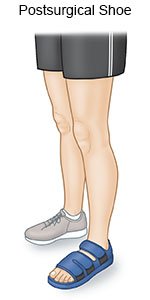Toe Amputation
Medically reviewed by Drugs.com. Last updated on Apr 6, 2025.
Toe amputation is surgery to remove all or part of your toe.
DISCHARGE INSTRUCTIONS:
Call your doctor or surgeon if:
- Your leg feels warm, tender, and painful. It may look swollen and red.
- You have severe pain.
- Blood soaks through your bandage.
- Your stitches come apart.
- You see a rash, blister, or sore on your wound.
- You have a fever or chills.
- Your wound is red, swollen, or draining pus.
- Your wound is bleeding.
- You have pain that does not go away even after you take pain medicine.
- You have questions or concerns about your condition or care.
Medicines:
You may need any of the following:
- Prescription pain medicine may be given. Ask your healthcare provider how to take this medicine safely. Some prescription pain medicines contain acetaminophen. Do not take other medicines that contain acetaminophen without talking to your healthcare provider. Too much acetaminophen may cause liver damage. Prescription pain medicine may cause constipation. Ask your healthcare provider how to prevent or treat constipation.
- Take your medicine as directed. Contact your healthcare provider if you think your medicine is not helping or if you have side effects. Tell your provider if you are allergic to any medicine. Keep a list of the medicines, vitamins, and herbs you take. Include the amounts, and when and why you take them. Bring the list or the pill bottles to follow-up visits. Carry your medicine list with you in case of an emergency.
Care for your wound as directed:
You may need to keep your wound dry until your stitches are removed. You may be told to carefully wash the wound with soap and water. Dry the area and put on new, clean bandages as directed. Change your bandages when they get wet or dirty. Check your incision area as directed. Look for signs of infection such as redness, swelling, or drainage.
Use assistive devices as directed:
- Use a cane, crutches, or a walker as directed. These devices will decrease or keep the weight off your foot while it heals.
- Use orthotics, prosthetics, or medical shoes as directed. For example, orthotics or custom inserts can help keep the pressure on your foot even. A foam spacer may also be used in place of your missing toe. Medical shoes such as those with a rocker sole also take pressure off your toes. These help you walk with comfort.

Follow up with your surgeon as directed:
You will need to return to have your stitches removed in 7 to 10 days or as directed. Write down your questions so you remember to ask them during your visits.
© Copyright Merative 2025 Information is for End User's use only and may not be sold, redistributed or otherwise used for commercial purposes.
The above information is an educational aid only. It is not intended as medical advice for individual conditions or treatments. Talk to your doctor, nurse or pharmacist before following any medical regimen to see if it is safe and effective for you.
Further information
Always consult your healthcare provider to ensure the information displayed on this page applies to your personal circumstances.
